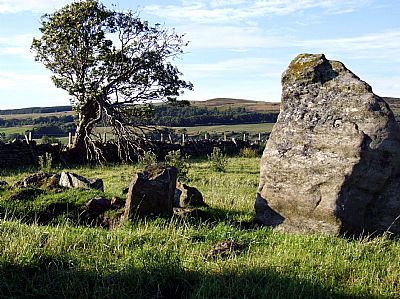WALTON FARM CHAMBERED CAIRN, (sometimes known as Carman Chambered Cairn), Walton Farm, Carman Muir.
ACCESS : This is within farmland with livestock. Access is via cattle routes which can be very muddy and difficult. Remember that this is private land. It is on Walton Farm, but very close to the bundary fence of Wallaceton Farm.
https://w3w.co/indulges.beans.homework
It is often surmised that our ancient ancestors had little appreciation of the aesthetics of scenery. Perhaps so, but they certainly appreciated scenery in terms of strategic and defensive outlook and the sense of place inhabited by the spirits of those that preceded them. This vantage point has great views over the Firth of Clyde. Not only that but it is overlooked by the hillfort on Carman Hill not far away and within a landscape that also had habitation that we now recognise from several hut rings. Even if the community was dispersed most of the time, it still anchored itself spiritually in this environment.
Elsewhere we wonder if the quarry below Carman Hill was a chambered cairn. It appeared on OS maps as "Faerie Knowe" and that raises considerations of where this community buried their dead, at least those with social standing.
This site on Walton Farm though is definately a burial cairn.
The large stones have been scattered by excavation and pilfering, but the largest, the portal stone, remains standing. A second has collapsed. These bring to mind entry points. Portal stones. Even though they would not have been actually serving as usable doorways, they seem to indicate the way in or out of the spirits of the dead. It has been suggested that the orientation with the setting sun is significant, but insufficient remains to confirm this.
Canmore tells us about trial excavations. Two portal stones, and two possible side slabs appeared to indicate a burial chamber of some 15ft in length. A deposit, apparently ritual, of at least 50 quartz pebbles was found, and the discovery of the butt of a broken axehead of polished stone, dates the site as Neolithic. [Canmore].
We don’t know how this Walton Farm was named - whether after a person or another place, but in a local context it is tantalising as a hint of local people being referred to as “outsiders”. We must quickly point out that the name origins of the farm and the cairn are not mutually linked, being of different eras entirely. It is coincidence that the cairn stands on the farm of this name, but while we are here, let's consider the origins of "Walton" too. Wiki tells us the first element in these names was variously Old English walh ‘foreigner’, ‘Briton’, genitive plural wala (see Wallace), w(e)ald ‘forest’, w(e)all ‘wall’, or wæll(a) ‘spring’, ‘stream’. the suffix tun ('town, farm, hamlet') and one of the prefixes wald ('a wood'), walesc ('foreigner') or walh ('farm worker'). [Wiki]. In other words the place or "ton" of the incomer / foreigner or "wal". Whether they were actually incomers to this area is a matter of conjecture. Marc Morris writing in The Anglo Saxons notes that it refers to people of Wales, Cornwall or Cumbria. If we take it further, it can refer to the Brythonic peoples squeezed to the west of the landmass with some moving northwards. It is not these people themselves that labelled themselves "Walton", but others. Old English derives from the Anglo Saxons, yet picks up Norman ("French") terms along the way. It was more the later incomers that were actually the "foreigners" than these people. Just over the dyke is Wallaceton Farm with the same name origin. It is ironic that one of Scotland's most iconic historical figures William Wallace gets his name from the same source.
When approaching history from a place rather than a chronoligical perspective, eras get superimposed on the landscape. The cairn is from the neolithic period ie late / new stone age. The eras are completely separate in time. The Kingdom of Strathclyde which was of a Brythonic people (hence Dumbarton, Dun of the Britons) was roughly the 7th century. As this Kingdom was at its apex while the Anglo Saxons were still asserting themselves amongst themselves to the south, it is unlikely that these two farms or at least their occupants were named by them, but rather much later names, whether consciously referring to history or simply liked.

A dramatic silhouette of the portal stone against clouds with a setting sun. The Firth of Clyde shimmers in the background.

The remaining vertical portal stone.



In this view you casn make out early vandalism in the form of etched intitials on the portal stone.

Stones have been widely distributed by tree removal, ploughing and intentional excavation in the past to search for burial items. That is the remaining erect portal stone in the background.

This view shows Dumbarton Rock in the distance.
ANCIENT SCOTLAND : https://www.ancient-scotland.co.uk/site/44
CANMORE : https://canmore.org.uk/site/42374/walton-farm
THE MEGALITHIC PORTAL : https://www.megalithic.co.uk/article.php?sid=32054
MORRIS, MARC : Book : The Anglo Saxons - A History of the Beginnings of England. Penguin Books. 2021. ISBN 978-I-15698-0.
WIKIPEDIA : https://en.wikipedia.org/wiki/Kingdom_of_Strathclyde
https://en.wikipedia.org/wiki/Wallace_(surname)

